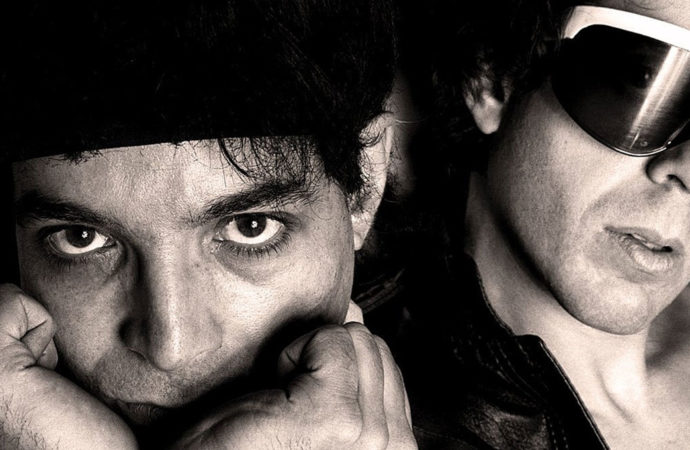England, United States; second half of the 1970s. Everything that has been built falls into ruin. The ivory towers of progressive rock collapse and new artistic personalities emerge who, nevertheless, refuse to build. Nihilistic horizons that in no way foresee the rampant commercialism that would take over the eighties. Black magic and sadomasochism in abrasive performances. Tormented spirits for whom life, in effect, only made sense for three days.
In this environment, what could be more appropriate than a duo called Suicide. Although in “life” they never left the underground circuit, these New Yorkers are acclaimed as the godfathers of the dark electronica of the eighties. The mix is difficult to define, in retrospect: minimalism, synth pop, synthpunk, electroclash…? Better labels of the time, like No Wave, a disruptive movement that we will talk about on another occasion and that ended up embracing them, and even forgiving them their low decibels.

Suicide’s debut makes the message clear: Suicide (1977). Mystique of denial. The sound is cold, synthetic, and the drum machine is used more as ambient noise than as percussion. Some songs play with the customs and habits of rock (including decontextualised surfer vibes in “Johnny”). Others land on a different planet.
The punks were nihilistic in their attitude, but in their songwriting they tended to retain a basic humanity: those three essential chords that allowed the songs to somehow reach the hearts of the audience. Suicide were more radical: “Rocket USA” is dominated by a percussive backdrop and Alan Vega’s voice, which sometimes moans, sometimes reverberates, sometimes even sings. The musical backgrounds, when there are any, are repetitive and foreign, as in “Ghost Rider” or “Che”. Even small concessions to beauty, soft (and this time, triacordic) songs like “Cheree” or “Keep Your Dreams” sound so rarefied that one doesn’t quite know how to feel. Another thing is the ten minutes of “Frankie Teardrop”, the almost a cappella story of “poor Frankie”, who kills his wife and children and commits suicide, amidst sudden howls and demented laughter. Painful to hear.
Suicide is the first known band to call themselves punk, back in the early days, but they disowned the term as soon as it was on sale. Their second album -another Suicide (1980)- was more melodic, but their breath no longer stank.
It was a time of gloomy atmospheres and mechanical monstrosities, which would soon make a mockery of Suicide’s simple drum machine. Masterfully sealing the end of early punk and the end of a decade, a certain Johnny Rotten left the Sex Pistols just before the cataclysm that would befall the band, which would leave in its wake a single album, countless provocations, a murder and an overdose at the age of 21. After a particularly disastrous concert (preserved for posterity), the lead singer of the legendary British band took to his heels: his bandmates had months to go. He went back to his real name, John Lydon, forgot about punk and set out to meet the biggest challenge for experimental rock at the end of the decade: to stop making the ears of his fans bleed.
His was no longer a rock ‘n’ roll band (l’horreur!), but a corporate one, and he presented it as such in his crisp public appearances. Public Image Ltd seems almost a joke of a name, as it corporatises what was the perpetual obsession of his previous band (and the key to their success): Public Image. The name reaches an even higher level of abstraction with its usual form, PiL.
From one year to the next, the Sex Pistols frontman made the leap from one dying wave to another: from punk to post-punk. Like Howard Devoto, he would boast of having left the sinking ship in time. The first album, known as First Issue (1978), sounded rabid and claustrophobic, more atonal than the punk it was moving away from, rarely reaching genuine cacophony. The alloy would cool on Metal Box (1979), a calculated album of dub and distortion, incorporating the latest developments in musical industrialism.

Instead of being wrapped in plastic (like the rest of the albums and Madonna’s tits), Metal Box consisted of a series of discs inside a metal box. Keith Levene’s guitars would also become mechanical – Veleno guitars, one hundred per cent aluminium – giving the music a cold, mineral coating (as can be seen on “Chant” or “Graveyard”). Lydon’s voice has come a long way since the rabid scream of the Pistols: now deep and nasal, as in “The Suit”, now between complaint and lament, as in the overwhelming “Careering”, although his natural position is spitting and vituperation.
Another difference with the old punk is the length of the songs, as “Albatross” and “Poptones” tend to run to ten minutes. (The man who walked around in an I HATE Pink Floyd T-shirt can’t be denied a modicum of ambition). Both differ from the symphonic rock suites in their dense, repetitive content, more bearable in “Poptones”. Focused on the disco movement – which they almost parody – would seem to be “Memories” and “Swan Lake/Death Disco”, a grotesque adaptation of the main motif from Tchaikovsky’s Swan Lake.
Metal sounds would end up dominating the decade in the making, but rarely would they creak so much: Metal Box can be conceived -along with London Calling (1979) by their ex-religionists The Clash- as the first British masterpiece of the eighties. On the next release, The Flowers of Romance (1981), Lydon would plunge into a minimalism that was anything but soothing (Kurt Cobain wondered how a handful of drum beats could work so well [with] Johnny Rotten screeching over the top). It’s only a few years before Lydon begins to tinker with the “Commercial Zone”, which coincides with the gradual shift in his Public Image: from front-heavy shock anti-establishment to variety anti-establishment.
The second half of the seventies – the truncated decade of Anglo-Saxon popular music – delved into experimentation, esotericism and industrial sounds. A list that does not pretend to be exhaustive: the Australian émigrés SPK, the Swedish pornographers Leather Nun, the noise experimentalist Boyd Rice (also known as NON) or the identity usurper John Zewizz, who sometimes signed as “John Cage” and sometimes as “Green Sex”, founder of the Inner-X-Musick label. For their part, the British Throbbing Gristle approached the pre-recorded sounds of musique concrète. As well as being a paradigmatic case of “industrial” music, they bequeathed us the name: Industrial Records was the company where they self-published, and from which they lent a hand to sympathisers such as Clock DVA, Monte Cazazza and… William Burroughs.
Throbbing Gristle made a genre of “sound product” outside the empire of tonality and harmony. The music of their early years is often a succession of noise and distortion. More than a “rock band”, neo-Dada and Fluxus-influenced performance artists (under the name COUM Transmissions), now into sculpting sound and bathing it in blood and shit. Social agitators who were dubbed destroyers of civilisation by conservative politician Nicholas Fairbairn (they loved it). An early show by member Genesis P-Orridge, called Prostitution, featured pornography by fellow member Cosey Fanni Tutti, dirty nappies, knives and used tampons. Live shows included coprophagy, self-mutilation, rough sex, fascist iconography, sadomasochism, blinding lights, excessive volume and pictures of the Holocaust.

The Second Annual Report, from 1977, is half studio, half live, with four versions of the same “Maggot Death” (which, fortunately, bear little resemblance) and the soundtrack to a COUM Transmissions film, “After Cease to Exist”, which is twenty minutes of unplugged sounds. The next work, D.o.A: The Third and Final Report of Throbbing Gristle (1978), remains inaccessible, though somewhat less so. Included were a sound collage of death threats received by the band and a version of their “melodic” single from the previous year, “United”… condensed to 16 seconds. They would mellow out a little on 20 Jazz Funk Greats (1979), considered, not coincidentally, one of the most influential albums of its time. It was necessary to have the will to be heard to contribute a drop to the demanding flows of history.
Everything in 20 Jazz Funk Greats is a lie. It’s not jazz, not funk, not jazz-funk… but a shapeless mishmash of genres. It’s not greatest hits either, but original avant-garde electronic material. There are 11 songs, not 20. And that cover featuring the members in a small field, smiling as if they had never broken a dish, was taken in an enclave known for its high number of suicides (one version of the photograph includes a corpse on the ground). In this way, Throbbing Gristle scrupulously complied with the slogan they set themselves in the days of their first performances: “guarantee disillusionment”. Making music, not noise, was the ultimate disappointment.









No one has posted any comments yet. Be the first person!